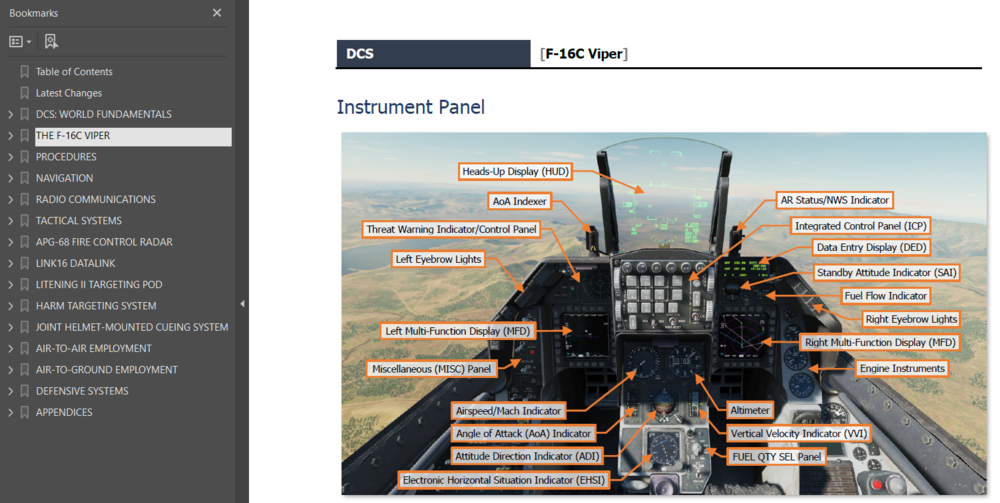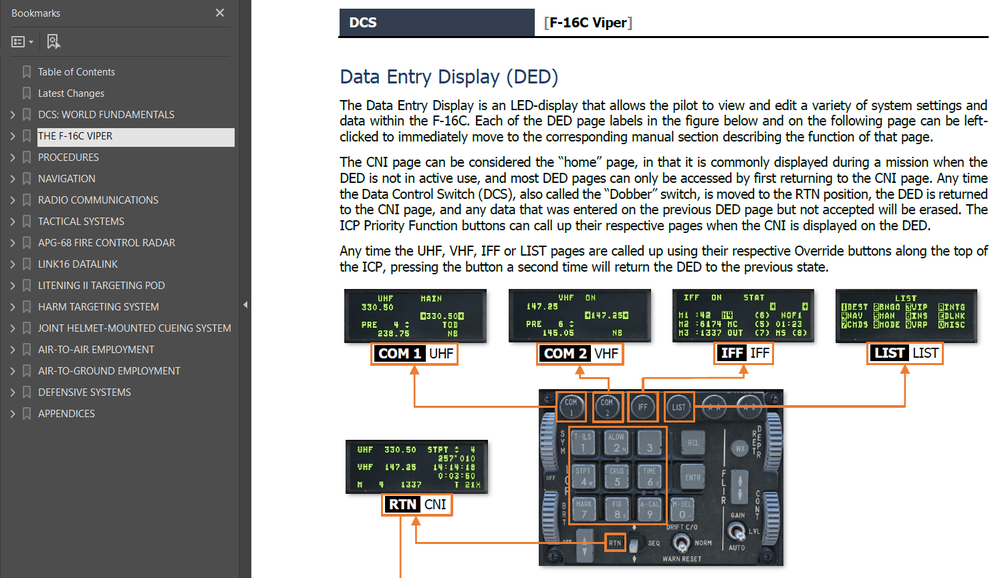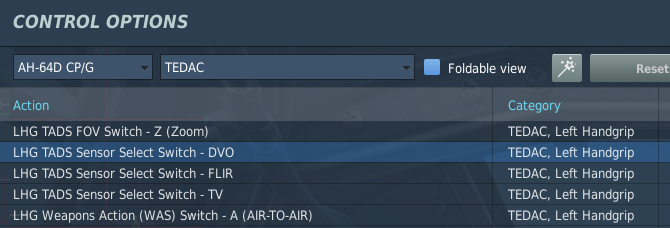-
Posts
2162 -
Joined
-
Last visited
-
Days Won
4
Content Type
Profiles
Forums
Events
Everything posted by Raptor9
-
Please review the most recent entry in the Latest Changes to see what has been revised in the latest manual update.
-

reported F-16 RWR is non-functional in Multiplayer
Raptor9 replied to Fropa's topic in Bugs and Problems
The current version of the manual was finalized several weeks ago, so there may have been changes since. When the next version of the manual is published with more revisions, it should also include any updates to the module that happen between manual versions. -
This has been reported internally. Thanks.
-
There are some myths here. Yes, helicopters can present a slow-moving target, as most would assume = easy target. But that is often not the case. Often times, engaging a helicopter is akin to attacking a ground target. It can be very easy to collide with the ground/obstacles or overshoot the target, and complicating the matter is that engaging a helicopter can effectively be like trying to shoot a Formula 1 race car as it twists and turns on a raceway at high speed. As long as you aren't caught out in the open, and you know there is a fighter coming for you, you actually have a reasonable chance of survival. I've not only successfully avoided hostile fighters in the trees and buildings, I've even shot them down on occasion. All you need to do is hide behind a hill, in a forest clearing, or in a cluster of buildings. Even when you can only hide on one side of an obstacle, say a building or on one end of a clearing, as the fighter breaks off from their attack to circle around from the other direction and try again, you can just as easily hover around to the other side by the time they re-orient for another pass. I've had AI aircraft try unsuccessfully for 15-20 minutes to get a shot at me, until they had to break off due to low fuel. Or I've had human players get impatient and dive down low and slow to try to get some additional time at getting a shot off on me, and then they can get smacked by my own weapons (but it is best to wait them out, since they will typically be further up against a fuel curve than you are). But again, the most important thing is knowing when you are under attack in the first place. The rest is just being more patient and disciplined than the guy trying to shoot you down. In the Ka-50 alone, examples of aircraft that I've shot down range from MiG-29's to A-10's, because whether it is the AI or a human player, the most common mistake they make is coming in low and slow to try to get a shot off. Gives me plenty of time to get behind an obstacle or shoot them with my own weapons, which can be just as accurate as theirs.
-
The updated DCS F-16C manual is now available on the DCS website on the Downloads>Documentation page. Respectfully, Raptor
-
The Go/No-Go torque values allow you to see what torques correspond with the Max Gross Weights. As seen in the video, if the aircraft weighed 21,730 lbs, it would take 100% torque to hover IGE. If the indicated torque value when attempting to hover IGE were to be 101%, or if you couldn't lift off the ground into a 5 foot IGE hover, than the actual aircraft gross weight is clearly exceeding the max allowable gross weight for dual-engine IGE hover. Likewise, if you lift off the ground to a 5 foot IGE hover and the indicated torque is 82%, but the Go/No-Go torque for OGE is 80%, that is telling me that I do not have sufficient power to hover at 80 feet. But the OGE Go/No-Go torque allows me to determine that in IGE conditions prior to even attempting to climb to an OGE hover. So in essence, the Go/No-Go torques let me know which torques should I expect to see at a 5 foot hover, if my actual gross weight is at either the IGE or OGE values in the MAX GWT window immediately below it. If I do a hover power check and my torques are above either of those values, I know I am overweight for hover operations at IGE or OGE altitudes respectively. Hence, Go/No-Go. In contrast, the REQUIRED torques are predicting what torques I should expect at 5 feet and 80 feet respectively, based on the current pressure altitude, free air temperature, and current gross weight. If those torques are lower than the Go/No-Go torque values, that lets me know my power margins in case I need to take on more fuel and/or munitions. However, you would never want to actually match your REQUIRED and Go/No-Go torques, because that means you have no torque margins for maneuvering, and that is assuming that the environmental conditions won't get worse as the day progressed, or worse at your objective area.
-
The updated manual will automatically replace the existing F-16 English manual in the Docs folder within the DCS Open Beta installation location. As such, if a customer does not have the Open Beta version installed, they cannot receive the new updated manual through the Open Beta updating process. However, the plan is to also post the updated manual to the DCS website. So even if you do not have the Open Beta version of DCS installed, you may still access the manual. But the manual within the DCS installation path will not be automatically updated until the Stable version of DCS receives an update to bring it to the corresponding version as Open Beta.
-
Hello everyone. I'm pleased to inform you that the next Open Beta update will include the first set of revisions and updates to the F-16 manual. The manual has increased in size from 318 to 452 pages, and includes a mix of revisions and new content. Below is a screenshot of the most recent entry in the Latest Changes list that illustrates what you can expect in the update. The next edition will also include a greater use of embedded and discrete hyperlinks to facilitate easier navigation. Expandable bookmark entries will be present, however in some cases there may be options to directly click on an entry to take you to the applicable section. For example, if you were to click on the orange box labeled "Data Entry Display (DED)" in the cockpit image above, the manual will proceed to the following page outlining the DED: From this page, you may then click on "CNI", and the manual will proceed to the specific sub-section explaining the DED's CNI page in greater detail. Not all figures will include hyperlinks (in some cases because the sections have not been completed yet), but if you mouse over a word box and your mouse pointer changes to a small hand icon, that will indicate that you may click to go directly to a manual section that explains that item or function in greater detail. Finally, I want to stress that this is just the first set in a series of updates. As you can see in the Latest Changes image above, there is still a ways to go; but the actual progress is further along than what you will see in the next manual version, and work has not stopped since pushing this version for publishing. Thank you to all the virtual Viper pilots out there for your patience. Respectfully, Raptor
- 77 replies
-
- 24
-

-

-
The F10 shows altitude above sea level, the HDU symbology is showing radar altitude. I'm assuming you are flying over a lake that is inland, and therefore is actually above sea level.
-
Any time the CPG changes a sight, the SLAVE function is de-selected by default. Not saying "At the moment TADS is selected as the sight."; saying "With TADS as the selected sight." The former implies a sequential action, the latter is simply a condition. If you want to slew the TADS with the MAN TRK controller, you must ensure that 1) TADS is the selected sight and 2) SLAVE is not selected (ie "unslaved"). Also, for future reference, ensure you do not violate Rule 1.16 regarding posting links to, copying text from, or referencing specific parts of restricted documents. I know the TC 1-251 from 2005 is marked as Approved for Public Release, Distribution is unlimited, but I'm just stating this here as a reminder to you (and others) to pre-emptively warn against future references of restricted documents. Even if a document can somehow be found on the internet, it cannot be posted here if there are restrictions on its distribution. It keeps everyone out of trouble, since DCS is a game meant for entertainment.
-
@corbu1, also keep in mind the original idea of the AH-64A was a Cold War era concept to offset the numerically superior Soviet armored forces that were expected to come across the central plains of Europe. In that concept, it was thought to be a World War 3 scenario, where the objective was to stop the advance of a large armor force before it decimated your own. The original design of the AH-64D's FCR (and AGM-114L) was to be a more efficient extension of that concept, where the concern was more about strategic survival, and the types of scenarios that would entail. But that goes down a larger discussion about Cold War hypotheticals, which I won't get into for multiple reasons.
-
There is a reason the FCR icons are colored yellow, in accordance with the color convention of the rest of the avionics. It doesn't tell you if it is friendly, enemy, or civilian. But it is the same as most other radar systems. If you are in an F-16 using the radar in GMT mode, it is just telling you that there are moving vehicles down there on the ground, not who is in them or who's coalition they belong to. Not to get on a soapbox, but this is one of the reasons why having a person with good situational awareness, training, and an understanding of the tactical situation is so critical. You can't rely on bells and whistles in the cockpit to tell you when to pull a trigger or not, or whether you should go left vs right. It's why so much money goes into training aircrews. Their military leadership is not only entrusting them with a multi-million dollar flying machine filled with technology, but they are entrusting them with the discretion to ensure that every munition that leaves their aircraft is employed in a responsible way, in accordance with their mission. You give a $30 million dollar aircraft to a pair of young men or women, that has the firepower to wipe out a company of tanks, armored fighting vehicles, or hundreds of infantry from several miles away; trust them to go somewhere into a hostile battlefield, at night, and expect them to accomplish objectives without supervision, using complex military tactics and procedures. If it came down to what a computer screen said as to whether a gunner decides to shoot or not shoot, anybody could do that job out of boot camp.
-
So you're asking for special keybinds that holds the 3-position switch in the Up/FLIR position as long as a key command is constantly being sent for that position from a joystick input, and accordingly does the same for the Down/DVO position, but then returns the switch to the Center/DTV position if neither of those other two positions are being continuously pressed?
-
In the AH-64D section in here from October 28: Development can only happen so fast with a game as complex as DCS, when trying to simulate an aircraft as complex as the AH-64D. Not every update can include new features, screenshots, or previews; nor will every update will be interesting to every player. A lot of this is very tedious, grinding work by the devs to program, implement, and test (simply stating more lines of code have been added for this project will rarely be interesting). Additionally, existing functions that are already in the game must also be maintained and bug-fixed, some of which are relied upon by future features to work correctly. No news to share. This is quite a big task to implement. It will take time, and will take patience.
-
I must have misunderstood you, I'm not sure what you are requesting.
-
-
As stated above, if you turn up the gain on a FLIR sensor, a lot of dissimilar objects can appear to be same brightness in FLIR sensors that have adjustable level/gain settings. I can't speak for how AGM-65 missiles should appear (which are what you linked in the post above), because I've never used them. But not all FLIR sensors are the same in sensitivity, resolution, or video output. But I can tell you I have personally flown at night, in various seasons (summer/winter), in areas with high-transmission power lines while using FLIR to navigate at low level altitudes. And power line stanchions, fence posts, and other such objects out there are quite easy to see in FLIR (and I wasn't even using modern day FLIR systems). What is not easy to see is the power lines themselves until you get quite close. Which is why the power line stanchions themselves are probably the only thing that kept me alive on many nights.
-
It's not about how hot the object is, it's about the rates of emission or reflection of infrared energy. Additionally, it also comes down to the ability of the specific FLIR sensor to distinguish and display the relative detections. If a FLIR sensor or its video output only has 5 levels of brightness between full white and full black, the temperature differences as they appear on a video display may not have the level of resolution that directly correlates with the actual differences in infrared emission/reflection rates. If a FLIR sensor and its video output have 20 levels of brightness between full white and full black, you will see a greater degree of difference across many objects; but again, that doesn't directly correlate with how physically hot or cold the object is. As an example from real-life usage, by messing with the level and gain of a FLIR sensor, I can make it so everything looks like Cookies & Cream ice cream, where everything appears to be almost completely black or completely white, with little in between (even when using a sensitive, high-resolution FLIR camera). When this happens, it can often be hard to see whether the FLIR is set to White-Hot or Black-Hot, and therefore the FLIR needs to be re-optimized. A FLIR sensor may need to be re-optimized several times over the course of a flight as thermal conditions in the environment change. I'm not describing how the F-16's TGP or AGM-65 seekers function specifically, because I have no first-hand use of the F-16 or Maverick missile, but I have extensive use with FLIR systems in other aircraft. What I'm trying to say is that there is a lot more to these systems in how they display thermal images of the environment besides just the apparent temperature of "hot" or "cold" objects. If I drive up the gain on a FLIR camera, where a running vehicle is already at it it's maximum brightness level in the video output, I can make it so a cooler object is at the same brightness level as a much hotter object, giving it an appearance of being at the same temperature. And while a lot of FLIR sensors have automatic gain control mechanisms in them, the sophistication and effectiveness of such functions vary, especially with older generation FLIR sensors. Even in DCS, I am often constantly adjusting the FLIR picture using manual level gain controls to get a better picture based on the video output. Only on the most sophisticated FLIR systems in recent years would you have automatic gain control logic that rivals the management of a human operator.
-
FLIR imaging works based on emissivity, not absolute "cold" or "hot". Everything retains, reflects, and emits thermal radiation at different rates, which allows infrared-based sensors to display the environment based on the different emissivity of the objects within the sensor's field-of-view. This makes FLIR sensors very effective across a wide spectrum of environmental conditions, compared to NVGs that operate using light amplification.
-

need tutorial for flying front seat and firing weapons Apache
Raptor9 replied to Ramstein's topic in DCS: AH-64D
The included manual has some abbreviated checklists for cockpit tasks in Appendix A toward the back, as well as more detailed instructions outlining each switch/button press for employing each weapon system in the Combat Employment chapter. While it doesn't have an arrow pointing to every button or switch that needs to be pressed, it does explicitly explain what they are along with images of the applicable MPD settings and the TADS/IHADSS symbology that should be seen. -
I would like to clarify that to directly select a point on the TSD as ACQ using the cursor, you need to press CAQ (R5) "Cursor Acquisition" prior to cursor-selecting the point, or select it from the COORD page like @kgillers3 said.
-
Very simple explanation: The light on the TAIL WHEEL button indicates whether it is physically locked or not; whereas the EUFD message indicates which state you have commanded the locking pin be in, or what state you have "selected", which is why it says "SEL" at the end of the EUFD message. The wheel is free-swiveling, meaning the only way for it to be locked is to move the tail in such a way the locking mechanism is aligned, so the tail wheel locking pin can drop into the hole and physically lock. When this happens, the "UNLOCK" light on the TAIL WHEEL button will extinguish.
-
The F-16 manual revision is over halfway finished, including well over 100 pages of new content. A preview of 4 new pages is not indicative of the totality of progress. The person doing the F-16 manual isn't the only one writing manuals, just the one that is responsible for a few of the aircraft, like the F-16, F-18 and A-10C.
- 77 replies
-
- 12
-

-

-
I almost exclusively fly with TrackIR, and I've had zero problems since release. As @Floyd1212 mentioned, there is a misunderstanding of how these systems work, and what these symbology elements represent. The rocket steering cursor ("I-beam") and the missile constraints box are not the same as similar symbology elements in HUDs in fixed wing aircraft. They do not represent virtual locations out the window, but rather relative offsets from datum lines. In addition, these symbology elements and their behavior are driven by the selected sight, the selected ACQ source, and the weapon modes. I understand it may be challenging, but the AH-64D is a very complex aircraft, with many different systems and methodologies compared to what most people are accustomed to with other modules.
-
@DoctorVixen, if you were expecting the ACQ LOS reticle (broken crosshairs) to move when George slews the TADS, you need to set the ACQ source to TADS. If you leave it in Fixed (FXD), it will never leave the Head Tracker diamond. This is correct as is. If that is not what you were trying to show, I'm not sure what you were expecting.





